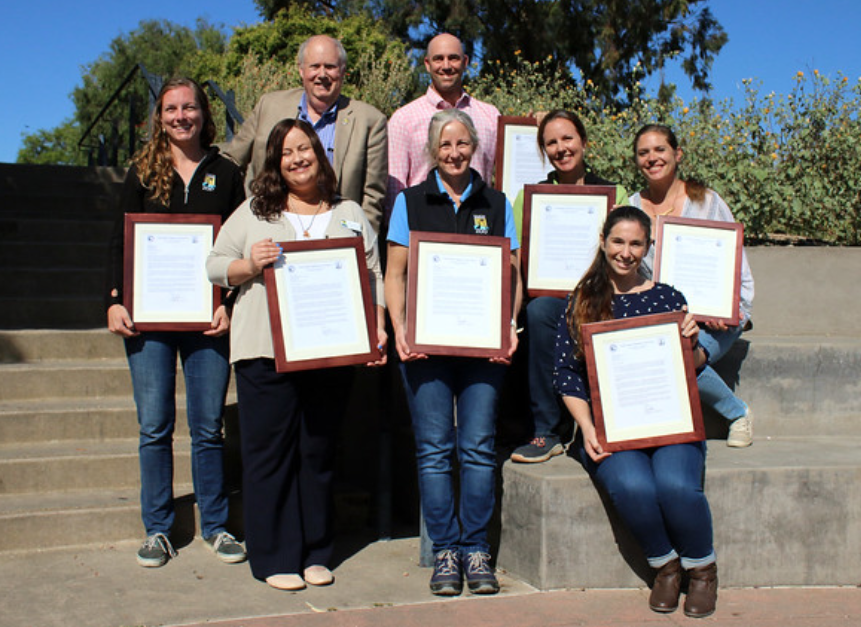SANTA BARBARA — Nine Santa Barbara Zoo employees received the U.S. Fish and Wildlife Service’s 2018 Recovery Champion Award today. The award recognizes their collective work to advance the recovery of endangered and threatened species along the California coast.
Every year the Service recognizes employees and conservation partners who exemplify dedication and commitment to endangered species recovery. This year’s award recipients are Rich Block, Aaron Marshall, Estelle Sandhaus, Julie Barnes, Rachel Ritchason, Carol Hunsperger, Nadya Seal Faith, David Meyer and Erin Arnold. They represent the Pacific Southwest Region, covering California, Nevada and parts of Oregon.
For the past 20 years, the Santa Barbara Zoo has worked with the Service to recover federally protected species like the California condor and Channel Islands fox through research, hands-on fieldwork, and education and outreach that benefits local, rare wildlife.
“The Zoo is very engaged in on-the-ground conservation for a wide range of endangered species,” said Steve Henry, field supervisor for the Service in Ventura. “They really do an exceptional job of educating visitors about local threatened and endangered wildlife through educational programs and exhibits, and we are extremely fortunate to have them in our backyard and to call them our partners in conservation.”
Santa Barbara Zoo biologists work side-by-side with Service California Condor Recovery Program biologists in the field to monitor condor nests and movement throughout their range. They also trap the birds for health checks, navigate treacherous terrain to install and operate live streaming nest cameras, and engage with volunteers and the public.
The Zoo is also instrumental in the award-winning Condor Kids curriculum, which uses the California condor to teach children in the Fillmore Unified School District about history, geography, biology and conservation.
“The California Condor Recovery Program would not be what it is today without the Santa Barbara Zoo; they play an active role in the hands-on management of the wild population in Southern California,” said Joseph Brandt, supervisory wildlife biologist with the California
Condor Recovery Program. “They are also great partners in educating the next generation about conservation through the Condor Kids program.”
For the last three breeding seasons the Zoo has taken the lead in rearing, rehabilitating, banding, and releasing abandoned and rescued federally protected western snowy plover eggs and chicks in the Santa Barbara and Ventura area.
In close collaboration with the National Park Service, U.S. Geological Survey, California Department of Parks and Recreation, California Department of Fish and Wildlife, Mountains Recreation and Conservation Authority and the Service, the Zoo works to reintroduce California red-legged frogs to their native habitat in the Santa Monica Mountains. The reintroduction program saw success in 2017 with the first wild-breeding frogs in the Santa Monica Mountains since the 1970s.
The unarmored threespine stickleback, a small, highly imperiled fish that exists in an extremely limited area in the upper Santa Clara River watershed, has new hope because of the Santa Barbara Zoo. The Zoo is currently investigating the possibility of a captive breeding program that could play a key role in the species’ recovery.
The Zoo has previously seen success in captive breeding, most notably with the Channel Islands fox: the Zoo assisted in the development of captive breeding methodologies. In 2016, after a decades-long partnership with the NPS, The Nature Conservancy and the Service, the team celebrated the removal of three subspecies of island fox from the endangered species list.
“We are honored and humbled to receive this special recognition from our U.S. Fish and Wildlife Service partners. We are not in this for the accolades, but see the conservation of local species as a primary responsibility of the Zoo. We are proud to be considered conservation partners with the Service,” said the Zoo’s chief executive officer, Rich Block.
To learn more about the Santa Barbara Zoo’s wildlife conservation programs, click here
The Santa Barbara Zoo is located on 30 acres of botanic gardens and is home to more than 500 individual animals in open, naturalistic habitats. It is accredited by the Association of Zoos & Aquariums (AZA), representing the highest level of animal care, and participates in AZA cooperative programs for endangered species including Asian elephant, California condor, Island fox, and Western lowland gorilla, among others. Visit www.sbzoo.org.
Established in 1987, the U.S. Fish and Wildlife Service’s Ventura field office works to conserve and protect threatened and endangered fish, wildlife and plants across the southern and central California coast, collaborating with communities and conservation partners to build a future that supports both people and our unique and diverse natural landscapes. To stay up-to-date on the conservation work of our staff follow us on Twitter or like us on Facebook.

